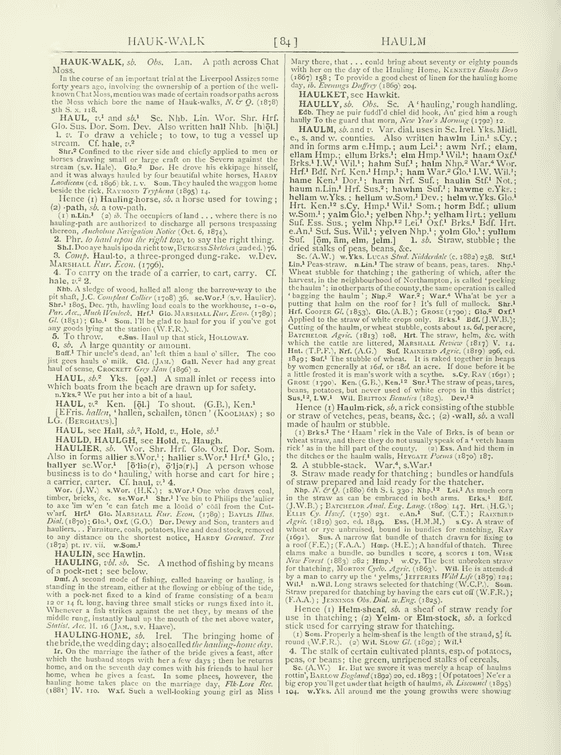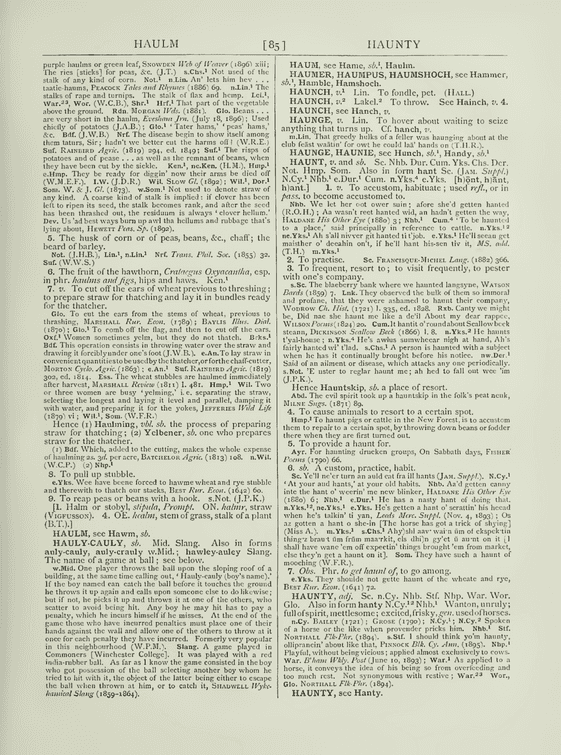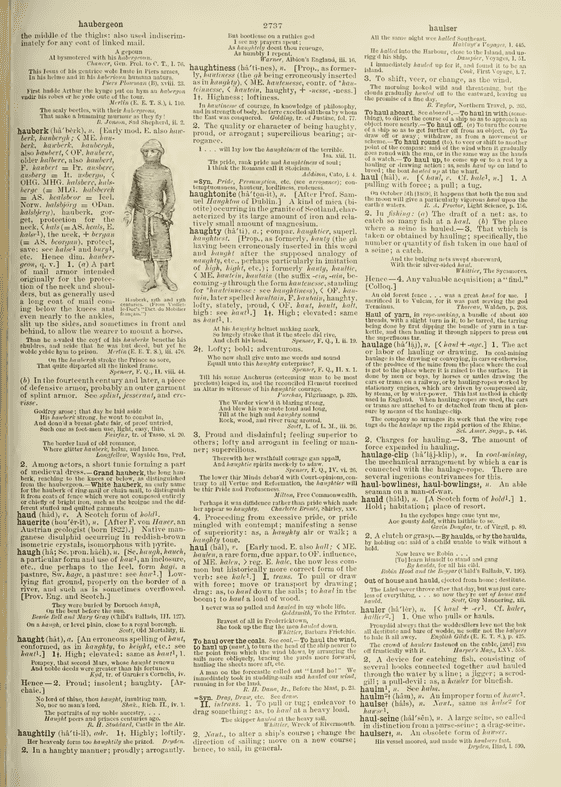Haulm
HAULM, sb. and v. Var. dial. uses in Sc. Irel. Yks. Midl. e.Cy., s.Cy. and w.Cy. counties. Also written hawlm Lin.1 s.Cy.; and in forms arm e.Hmp.; aum Lei.1; awm Nrf.; elam, ellam Hmp.; ellum Brks.1; elm Hmp.1 Wil.1; haam Oxf.1 Brks.1 I.W.1 Wil.1; hahm Suf.1; halm Nhp.2 War.4 Wor. Hrf.1 Bdf. Nrf. Ken.1 Hmp.1; ham War.2 Glo.1 I.W. Wil.1; hame Ken.1 Dor.1; harm Nrf. Suf.; haulin Stf.1 Not.; haum n.Lin.1 Hrf. Sus.2; hawhm Suf.1; hawme e.Yks.; hellam w.Yks.; hellum w.Som.1 Dev.; helm w.Yks. Glo.1 Hrt. Ken.1 Ken.2 s.Cy. Hmp.1 Wil.1 Som.; horm Bdf.; ullum w.Som.1; yalm Glo.1; yelben Nhp.1; yelham Hrt.; yellum Suf. Ess. Sus.; yelm Nhp.1 Nhp.2 Lei.1 Oxf.1 Brks.1 Bdf. Hrt. e.An.1 Suf. Sus. Wil.1; yelven Nhp.1; yolm Glo.1; yullum Suf. [ǭm, ām, elm, jelm.] 1. sb. Straw, stubble; the dried stalks of peas, beans, &c. Sc. (A.W.) w.Yks. Lucas Stud. Nidderdale (c. 1882) 258. Stf.1 Lin.1 Peas-straw. n.Lin.1 The straw of beans, peas, tares. Nhp.1 Wheat stubble for thatching; the gathering of which, after the harvest, in the neighbourhood of Northampton, is called ‘peeking the haulm’; in other parts of the county, the same operation is called ‘bagging the haulm’; Nhp.2 War.2; War.4 Wha'at be yer a putting that halm on the roof for? It's full of mullock. Shr.1 Hrf. Cooper Gl. (1853). Glo. (A.B.); Grose (1790); Glo.2 Oxf.1 Applied to the straw of white crops only. Brks.1 Bdf. (J.W.B.); Cutting of the haulm, or wheat stubble, costs about 1s. 6d. per acre, Batchelor Agric. (1813) 108. Hrt. The straw, helm, &c. with which the cattle are littered, Marshall Review (1817) V. 14. Hnt. (T.P.F.), Nrf. (A.G.) Suf. Rainbird Agric. (1819) 296, ed. 1849; Suf.1 The stubble of wheat. It is raked together in heaps by women generally at 16d. or 18d. an acre. If done before it be a little frosted it is man's work with a scythe. s.Cy. Ray (1691); Grose (1790). Ken. (G.B.), Ken.1 Ken.2 Sur.1 The straw of peas, tares, beans, potatoes, but never used of white crops in this district; Sus.1 Sus.2, I.W.1 Wil. Britton Beauties (1825). Dev.1 Dev.3 Hence (1) Haulm-rick, sb. a rick consisting of the stubble or straw of vetches, peas, beans, &c.; (2) Haulm-wall, sb. a wall made of haulm or stubble. (1) Brks.1 The ‘Haam’ rick in the Vale of Brks. is of bean or wheat straw, and there they do not usually speak of a ‘vetch haam rick’ as in the hill part of the county. (2) Ess. And hid them in the ditches or the haulm walls, Heygate Poems (1870) 187. 2. A stubble-stack. War.4, s.War.1 3. Straw made ready for thatching; bundles or handfuls of straw prepared and laid ready for the thatcher. Nhp. N. & Q. (1880) 6th S. i. 330; Nhp.1 Nhp.2 Lei.1 As much corn in the straw as can be embraced in both arms. Brks.1 Bdf. (J.W.B.); Batchelor Anal. Eng. Lang. (1809) 147. Hrt. (H.G.); Ellis Cy. Hswf. (1750) 231. e.An.1 Suf. (C.T.); Rainbird Agric. (1819) 302, ed. 1849. Ess. (H.M.M.) s.Cy. A straw of wheat or rye unbruised, bound in bundles for matching, Ray (1691). Sus. A narrow flat bundle of thatch drawn for fixing to a roof (F.E.); (F.A.A.) Hmp. (H.E.); A handful of thatch. Three elams make a bundle, 20 bundles 1 score, 4 scores 1 ton, Wise New Forest (1883) 282; Hmp.1 w.Cy. The best unbroken straw for thatching, Morton Cyclo. Agric. (1863). Wil. He is attended by a man to carry up the ‘yelms,’ Jefferies Wild Life (1879) 124; Wil.1 n.Wil. Long straws selected for thatching (W.C.P.). Som. Straw prepared for thatching by having the ears cut off (W.F.R.); (F.A.A.); Jennings Obs. Dial. w.Eng. (1825). Hence (1) Helm-sheaf, sb. a sheaf of straw ready for use in thatching; (2) Yelm- or Elm-stock, sb. a forked stick used for carrying straw for thatching. (1) Som. Properly a helm-sheaf is the length of the strand, 5½ ft. round (W.F.R.). (2) Wil. Slow Gl. (1892); Wil.1 4. The stalk of certain cultivated plants, esp. of potatoes, peas, or beans; the green, unripened stalks of cereals. Sc. (A.W.) Ir. But we swore it was merely a heap of haulms rottin', Barlow Bogland (1892) 20, ed. 1893; [Of potatoes] Ne'er a big crop you'll get under that heigth of haulms, Barlow Lisconnel (1895) 104. w.Yks. All around me the young growths were showing purple haulms or green leaf, Snowden Web of Weave (1896) xiii; The ries [sticks] for peas, &c. (J.T.) s.Chs.1 Not used of the stalk of any kind of corn. Not.1 n.Lin. An' lets him hev... taatie-haums, Peacock Tales and Rhymes (1886) 69. n.Lin.1 The stalks of rape and turnips. The stalk of flax and hemp. Lei.1, War.2 War.3, Wor. (W.C.B.), Shr.1 Hrf.1 That part of the vegetable above the ground. Rdn. Morgan Wds. (1881). Glo. Beans... are very short in the haulm, Evesham Jrn. (July 18, 1896); Used chiefly of potatoes (J.A.B.); Glo.1 ‘Tater hams,’ ‘peas' hams,’ &c. Bdf. (J.W.B.) Nrf. The disease begin to show itself among them taturs, Sir; hadn't we better cut the harms off? (W.R.E.) Suf. Rainbird Agric. (1819) 294, ed. 1849; Suf.1 The risps of potatoes and of pease... as well as the remnant of beans, when they have been cut by the sickle. Ken.1, ne.Ken. (H.M.), Hmp.1 e.Hmp. They be ready for diggin' now their arms be died off (W.M.E.F.). I.W. (J.D.R.) Wil. Slow Gl. (1892); Wil.1, Dor.1 Som. W. & J. Gl. (1873). w.Som.1 Not used to denote straw of any kind. A coarse kind of stalk is implied: if clover has been left to ripen its seed, the stalk becomes rank, and after the seed has been thrashed out, the residuum is always ‘clover hellum.’ Dev. Us 'ad best ways burn up awl tha hellums and rubbage that's lying about, Hewett Peas. Sp. (1892). 5. The husk of corn or of peas, beans, &c., chaff; the beard of barley. Not. (J.H.B.), Lin.1, n.Lin.1 Nrf. Trans. Phil. Soc. (1855) 32. Suf. (W.W.S.) 6. The fruit of the hawthorn, Crataegus Oxyacantha, esp. in phr. haulms and figs, hips and haws. Ken.1 7. v. To cut off the ears of wheat previous to threshing; to prepare straw for thatching and lay it in bundles ready for the thatcher. Glo. To cut the ears from the stems of wheat, previous to thrashing, Marshall Rur. Econ. (1789); Baylis Illus. Dial. (1870); Glo.1 To comb off the flag, and then to cut off the ears. Oxf.1 Women sometimes yelm, but they do not thatch. Brks.1 Bdf. This operation consists in throwing water over the straw and drawing it forcibly under one's foot (J.W.B.). e.An. To lay straw in convenient quantities to be used by the thatcher, or for the chaff-cutter, Morton Cyclo. Agric. (1863); e.An.1 Suf. Rainbird Agric. (1819) 302, ed. 1814. Ess. The wheat stubbles are haulmed immediately after harvest, Marshall Review (1811) I. 481. Hmp.1 Wil. Two or three women are busy ‘yelming,’ i.e. separating the straw, selecting the longest and laying it level and parallel, damping it with water, and preparing it for the yokes, Jefferies Wild Life (1879) vi; Wil.1, Som. (W.F.R.) Hence (1) Haulming, vbl. sb. the process of preparing straw for thatching; (2) Yelbener, sb. one who prepares straw for the thatcher. (1) Bdf. Which, added to the cutting, makes the whole expense of haulming 2s. 3d. per acre, Batchelor Agric. (1813) 108. n.Wil. (W.C.P.) (2) Nhp.1 8. To pull up stubble. e.Yks. Wee have beene forced to hawme wheat and rye stubble and therewith to thatch our stacks, Best Rur. Econ. (1642) 60. 9. To reap peas or beans with a hook. s.Not. (J.P.K.) [1. Halm or stobyl, stipula, Prompt. ON. halmr, straw (Vigfusson). 4. OE. healm, stem of grass, stalk of a plant (B.T.).]
HAULM, see Hawm, sb.


Source : Century Dictionary web : http://triggs.djvu.org/century-dictionary.com/splash3.html
